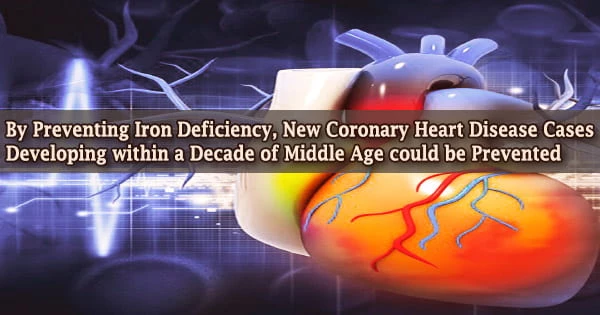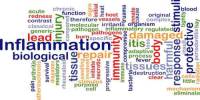According to a study published today in ESC Heart Failure, a journal of the European Society of Cardiology (ESC), around 10% of new coronary heart disease cases arising within a decade of middle age could be averted by eliminating iron deficiency.
“This was an observational study and we cannot conclude that iron deficiency causes heart disease,” said study author Dr. Benedikt Schrage of the University Heart and Vasculature Centre Hamburg, Germany. “However, evidence is growing that there is a link and these findings provide the basis for further research to confirm the results.”
Iron is a vital nutrient in the diet. It is required for a variety of body functions, including the transportation of oxygen in our blood, which is necessary for generating energy for daily activities.
Our body’s iron stores become depleted if we don’t get enough iron in our diet (low). This can make us fatigued and weaken our immune systems. It may be beneficial to include iron-rich foods in our diet.
Previous research has connected iron deficiency to worse outcomes in people with cardiovascular illnesses such as heart failure, including hospitalizations and death. In the FAIR-HF trial, the intravenous iron treatment improved symptoms, functional capacity, and quality of life in patients with heart failure and iron deficiency.
The FAIR-HF 2 study is examining the effect of intravenous iron supplementation on the risk of death in individuals with heart failure based on these findings. The goal of this study was to see if the link between iron deficiency and outcomes was also seen in the general population.
A total of 12,164 people from three European population-based cohorts were involved in the study. The median age was 59, and women made up 55 percent of the population.
Cardiovascular risk factors and comorbidities such as smoking, obesity, diabetes, and cholesterol were examined during the baseline study visit via a full clinical assessment that included blood samples.
Iron deficiency symptoms are not exclusive to iron deficiency (i.e. not pathognomonic). Because iron is required for the correct activity of numerous enzymes, a wide range of symptoms may develop over time, either as a secondary result of anemia or as other fundamental effects of the iron shortage.
Absolute iron deficiency is the traditional way of assessing iron status but it misses circulating iron. The functional definition is more accurate as it includes both measures and picks up those with sufficient stores but not enough in circulation for the body to work properly.
Dr. Benedikt Schrage
Participants were classified as iron deficient or not iron deficient based on two definitions: 1) absolute iron deficiency, which only includes stored iron (ferritin); and 2) functional iron insufficiency, which includes both stored iron (ferritin) and iron in circulation for use by the body (transferrin).
Dr. Schrage explained: “Absolute iron deficiency is the traditional way of assessing iron status but it misses circulating iron. The functional definition is more accurate as it includes both measures and picks up those with sufficient stores but not enough in circulation for the body to work properly.”
Incidences of coronary heart disease and stroke, as well as death from cardiovascular disease and all-cause death, were tracked. After adjusting for age, sex, smoking, cholesterol, blood pressure, diabetes, body mass index, and inflammation, the researchers looked at the link between iron deficiency and incident coronary heart disease, stroke, cardiovascular mortality, and all-cause mortality.
The incident disease analyses excluded participants who had a history of coronary heart disease or stroke at baseline. At the start of the study, 60% of the individuals had an absolute iron deficit and 64% had functional iron deficiency. There were 2,212 fatalities (18.2%) with a median follow-up of 13.3 years.
A total of 573 people (4.7 percent) died as a result of cardiovascular disease. Coronary heart disease (8.5%) and stroke (6.3%) were diagnosed in 1,033 (8.5%) and 766 (6.3%) patients, respectively.
Because iron is required for bacterial development, its bioavailability is a key element in infection control. As a result, blood plasma contains iron securely bonded to transferrin, which is taken up by cells via endocytosis, preventing bacteria from accessing it.
In comparison to those who did not have functional iron insufficiency, functional iron deficiency was linked to a 24 percent increased risk of coronary heart disease, a 26 percent increased risk of cardiovascular mortality, and a 12 percent increased risk of all-cause mortality.
The absolute iron deficit was connected to a 20% increased risk of coronary heart disease when compared to no absolute iron deficiency, but not mortality. There were no links found between iron status and stroke occurrence.
The population attributable fraction was estimated, which estimates the proportion of occurrences that would have been prevented in ten years if everyone had the risk of those without iron deficiency at baseline.
Age, sex, smoking, cholesterol, blood pressure, diabetes, BMI, and inflammation were all factored into the models. Functional iron insufficiency was responsible for 5.4 percent of all deaths, 11.7 percent of cardiovascular deaths, and 10.7 percent of new coronary heart disease diagnoses throughout a 10-year period.
“This analysis suggests that if iron deficiency had been absent at baseline, about 5% of deaths, 12% of cardiovascular deaths, and 11% of new coronary heart disease diagnoses would not have occurred in the following decade,” said Dr. Schrage.
“The study showed that iron deficiency was highly prevalent in this middle-aged population, with nearly two-thirds having functional iron deficiency,” said Dr. Schrage. “These individuals were more likely to develop heart disease and were also more likely to die during the next 13 years.”
Future research should look at these associations in younger and non-European cohorts, according to Dr. Schrage. He said: “If the relationships are confirmed, the next step would be a randomized trial investigating the effect of treating iron deficiency in the general population.”
















